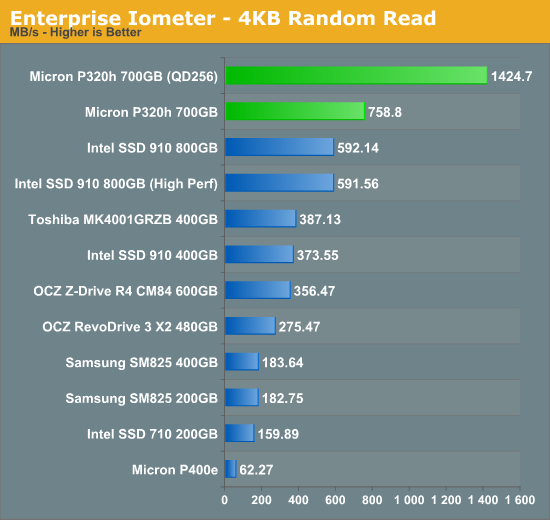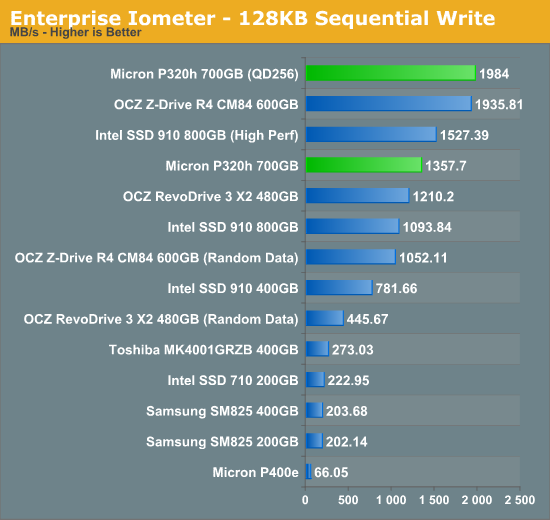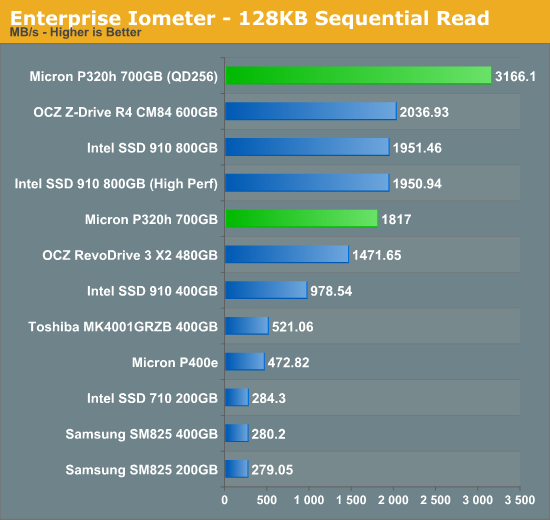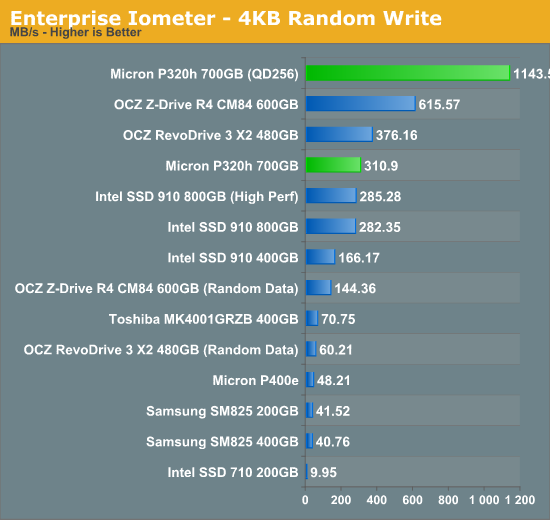Micron P320h PCIe SSD (700GB) Review
by Anand Lal Shimpi on October 15, 2012 3:00 AM ESTRandom Read/Write Speed
The four corners of SSD performance are as follows: random read, random write, sequential read and sequential write speed. Random accesses are generally small in size, while sequential accesses tend to be larger and thus we have the four Iometer tests we use in all of our reviews. For our enterprise suite we make a few changes to our usual tests.
Our first test writes 4KB in a completely random pattern over all LBAs on the drive (compared to an 8GB address space in our desktop reviews). We perform 32 concurrent IOs (compared to 3) and run the test until the drive being tested reaches its steady state. The results reported are in average MB/s over the entire time. We use both standard pseudo randomly generated data for each write as well as fully random data to show you both the maximum and minimum performance offered by SandForce based drives in these tests. The average performance of SF drives will likely be somewhere in between the two values for each drive you see in the graphs. For an understanding of why this matters, read our original SandForce article.
Excluding the two SandForce data points using highly compressible data, the P320h is the new king here. At least in the 700GB configuration the P320h is able to offer better steady state 4KB random write performance than Intel's SSD 910. The drive also delivers over 6x the performance of Micron's 2.5" P400e.

Random read performance is an even more impressive showing for the P320h at 758MB/s. This is truly the benefit of having 32 NAND concurrently accessible channels, given a heavy workload there's more than enough data to parallelize and stripe across all channels.
Sequential Read/Write Speed
Similar to our other Enterprise Iometer tests, queue depths are much higher in our sequential benchmarks. To measure sequential performance I ran a 1 minute long 128KB sequential test over the entire span of the drive at a queue depth of 32. The results reported are in average MB/s over the entire test length.

Peak sequential write performance is slightly behind Intel's SSD 910 operating in its 38W high performance mode, but still very competitive. At 1357MB/s workloads that need to move large blocks of data will enjoy great performance on the P320h. Micron claims much higher sequential read/write numbers under Linux at 256 concurrent IOs.

Sequential read performance is also very strong at 1817MB/s. The 910 as well as OCZ's Z-Drive R4 manage better performance here.











57 Comments
View All Comments
speculatrix - Tuesday, October 16, 2012 - link
flash memory comes in different forms and longevities.the best SLC flash will outperform and outlast the cheapest TLC flash by considerable margins, but at a cost.
car analogy: do you want a performance car which is extremely well built and designed to survive in harsh environments, or a cheap family car which can only survive a Californian "winter"?
milkod2001 - Monday, October 15, 2012 - link
They have to make this thing bootable and sell 120GB version for 300 bucks max, until then this is just like reading about NASA's new spaceship(interesting but no use for 99% of users)kevith - Monday, October 15, 2012 - link
Spot on!A5 - Monday, October 15, 2012 - link
If you only care about consumer-ready cheap stuff, there are plenty of really boring tech sites out there for you to read.ender8282 - Monday, October 15, 2012 - link
I was just talking with a co-worker a little while ago about how a device like this would give us more head room. It is extremely relevant to our workload, and I'm glad to see this article. Just because it isn't for home use you shouldn't ignore it. If this technology works (and works well) in the enterprise market, it will likely eventually trickle down to the consumer market. Would have liked to see prices, but if this is comparable to a high end raid controller, plus a bunch of fast SSDs it will likely be an option for lots of people.taltamir - Monday, October 15, 2012 - link
This is not for home users, its for enterprises with a lot of money and extreme speed needs.mattlach - Tuesday, October 16, 2012 - link
It's not intended for you, or me, or any other consumers.This is a enterprise server part, and for that market its probably priced about right.
I would LOVE to see a bootable native PCIe consumer drive with MLC NAND priced more reasonably for the consumer market, and we likely will in the not TOO distant future, but they aren't here yet.
zlyles - Tuesday, October 16, 2012 - link
What you fail to realize is these SSD's (Micron P320h, Intel 910 and OCZ Z-Drive) are targeted at enterprise markets. The majority of these enterprise customers would purchase these drives as high IOPS storage or for running virtual servers/desktops from. Most of these companies are likely using a virtualized solution(VMware ESXi) in which case the hypervisor is loaded into ram at boot anyway, not much point in booting the OS from SSD.If you are looking for a solution for 99% of users, I'm not really sure why you are even looking at PCI-e SSD's, there is a VERY small market for PCI-e SSD's(bootable or not) on the consumer side.
JellyRoll - Monday, October 15, 2012 - link
Man! For the tens of thousands of dollars that customers would spend on one of these SSDs there is no way in the world that anyone would ever run one under 128QD, ever.These are designed to be run 100% full bore, not at QD 1. These benchmarks are totally irrelevant, and have no real meaning. This is like testing an Nascar vehicle in a small parking lot.
Sivar - Monday, October 15, 2012 - link
You're right, who in their right mind would run all these irrelevant real-world database tests to see actual performance in the target market?I'm sure you're speaking from a lot of industry experience. I'm also sure you've ever seen a sustained queue depth of 128 on any real-world system.